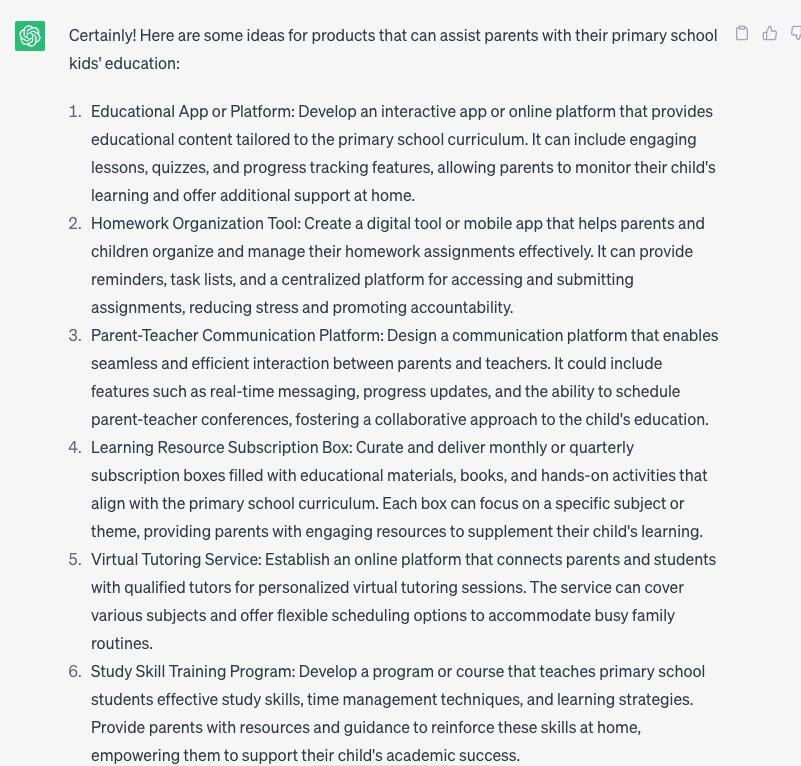The product development cycle comprises 8 key stages. We can take advantage of OpenAI’s ChatGPT at each stage of product development. In this article, we will develop a new product by using ChatGPT and demonstrate how OpenAI and ChatGPT can be effectively utilised across each stage of product development.
“AI is like having a personal assistant who knows you better than you know yourself.”
1. How does ChatGPT help in idea generation?
By integrating AI, such as ChatGPT, we can engage with users to uncover their needs and desires. With natural language processing capabilities, OpenAI can swiftly analyze and extract valuable insights from the vast amount of data generated. The ability of OpenAI to process large volumes of data enables us to gain deeper insights into user preferences and market trends.
I used ChatGPT to generate ideas for a product that can assist parents who have school going children. Here is what I got…

2. How ChatGPT can help during validation phase of product development?
Validating ideas is essential to ensure that we invest resources in viable, feasible and desirable products. OpenAI can assist in crafting surveys to gather feedback from potential customers. By leveraging AI’s analytical capabilities, we can swiftly analyze survey responses to identify patterns, preferences, and areas of improvement. This data-driven approach empowers product teams to make informed decisions based on concrete insights.
I used ChatGPT to ask some basic validation and estimation questions for my product.

3. How can OpenAI support in design phase of product development?
OpenAI can generate design ideas, offering a fresh perspective and inspiring creativity. These generated concepts can be further refined and validated with potential customers through usability testing.
Here is a design concept suggested by ChatGPT for my example case.

4. How can OpenAI support during concept validation phase of product development?
ChatGPT can help generate testing scenarios for usability testing. By leveraging AI-driven analytics, product teams can gain deeper insights into user behavior and interactions. This allows for a more comprehensive understanding of how users navigate and engage with the product, leading to valuable refinements and improvements.
5. How can OpenAI support to write or debug code for product engineers?
AI tools can assist with code generation, bug detection, and testing. By leveraging AI-driven automation, product teams can streamline development processes, reduce errors, and accelerate time-to-market.
Here is the code written by ChatGPT for my example product.

6. How can OpenAI support in the testing and launch of the product?
Testing is a crucial stage to ensure the quality and reliability of the product. OpenAI can support this phase by automating testing procedures, enabling faster and more comprehensive test coverage. AI-driven testing tools can analyze large datasets, identify patterns, and provide actionable insights to improve the product’s performance, reliability, and security.
By leveraging AI-driven marketing analytics, product teams can gain valuable insights into customer segmentation, behavior, and preferences. This enables targeted marketing campaigns, personalized messaging, and optimized customer acquisition strategies, ultimately increasing the chances of a successful product launch.
AI-driven analytics and monitoring tools can help track user engagement, gather feedback, and identify areas for continuous improvement. By leveraging AI-powered insights, product teams can make data-driven decisions to enhance the product’s features, address user concerns, and drive customer satisfaction.
In conclusion, AI has the potential to revolutionize each stage of the product development process. From idea generation to post-launch optimization, AI-driven tools and analytics empower product teams to unlock greater speed, efficiency, and quality.
